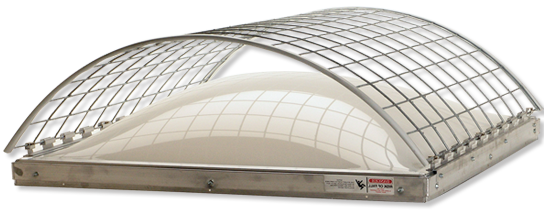OSHA Regulation
The Occupational Safety and Health Act makes each employer responsible for furnishing employees “a place of employment which (is) free from recognized Hazards”
29 CFR §1910.23
Guarding Floor and Wall Openings and Holes.
(a)(4) Every skylight floor opening and hole shall be guarded by a standard skylight screen or a fixed standard railing on all exposed sides.
(e)(8) Skylight screens shall be of such construction and mounting that they are capable of withstanding a load of 200 poinds applied perpendicular at any one area of the screen. They shall also be of such construction and mounting that under ordinary loads or impact, they will not deflect downward sufficiently to break the glass below them. The construction shall be of grillwork with openings not more than 4 inches long or slatwork with openings not more than 2 inches wide with length unrestricted.
29 CFR §1926.501
Duty to have fall protection.
(a) General. (1) This section sets forth requirements for employers to provide fall protection systems. All fall protection required by this section shall conform to the criteria set forth in 1926.502 of this subpart. (a)(2) The employer shall determine if the walking/working surfaces on which its employees are to work have the strength and structural integrity to support employees safely. Employees shall be allowed to work on those surfaces only when the surfaces have the requisite strength and structural integrity.
(b)(4) Holes. (i) Each employee on walking/working surfaces shall be protected from falling through holes (including skylights) more than 6 feet (1.8m) above lower levels, by personal fall arrest systems, covers, or guardrail systems erected around such holes. (ii) Each employee on a walking/working surface shall be protected from tripping in or stepping into or through holes (including skylights) by covers. (iii) Each employee on a walking/working surface shall be protected from objects falling through holes (including skylights) by covers.
OSHA Citations and Penalties
Citations issued by the Area Director. After the compliance officer reports findings, the area director determines what citations, if any, will be issued, and what penalties, if any, will be proposed.
Citations inform the employer and employees of the regulations and standards alleged to have been violated and of the proposed length of time set for their abatement. The employer will receive citations and notices of proposed penalties by certified mail. The employer must post a copy of each citation at or near the place a violation occurred, for three days or until the violation is abated, whichever is longer.
Penalties
These are the types of violations that may be cited and the penalties that may be proposed:
Other than Serious Violation – A violation that has a direct relationship to job safety and health, but probably would not cause death or serious physical harm. A proposed penalty of up to $7,000.00 for each violation is discretionary. A penalty for any other-other-than-serious violation may be adjusted downward by as much as 95 percent, depending on the employer’s good faith (demonstrated efforts to comply with the Act), history of pervious violations, and size of business. When the adjusted penalty amounts to less than $50, no penalty is proposed.
Serious Violations – A violation where there is substantial probability that death or serious physical harm could result and that the employer knew, or should have known, of the hazard. A mandatory penalty of up to $7,000 for each violation is proposed. A penalty for a serious violation may be adjusted downward, based on the employer’s good faith, history of previous violations, the gravity of the alleged violation, and size of business.
Willful Violation – A violation that the employer intentionally and knowingly commits. The employer either knows that what he or she is doing constitutes a violation, or is aware that a hazardous condition existed and made no reasonable effort to eliminate it.
Penalties of up to $70,000 may be proposed for each willful violation, with a minimum penalty of $5,000 for each violation. A proposed penalty for a willful violation may be adjusted downward, depending on the size of the business and its history of previous violations. Usually, no credit is given for good faith.
If an employer is convicted of a willful violation of a standard that has resulted in the death of an employee, the offense is punishable by a court-imposed fine or by imprisonment for up to six months, or both. A fine of up to $250,000 for an individual, or $500,000 for a corporation, may be imposed for a criminal conviction.


